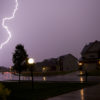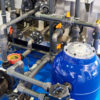A DIY Guide to Cleaning a Green Swimming Pool
It’s almost swim season and your pool is swamp green. What do you do? You can call a pool cleaning professional and we can take the worry away from you.
However, if you decide to do it yourself, we will be providing some tips over the next few days to help you do it well and maybe save you some time and money in the process.
Before we start let’s review some things to make sure everyone is on the same playing field:
This guide is for pools that were blue and clear last season and just got away from you in the off season. If the pool sat dormant for several seasons and the pool has turned into a pond, these steps may not solve your problems. Please call a professional. A drain and scrub or acid wash may be the better course of action for your pool.
If your pool is full of soapy algaecides and or Biguanides, this guide will not work for you. Please call a pool professional to come check out your pool water, as you may need to drain water before attempting to clear the pool.
Read the guide through before going shopping. The shopping list assumes a normal sized backyard pool. If your pool is oversized you should buy more, whereas if your pool is smaller than average you should buy less. The shopping list assumes you have a pool hose, vacuum and good tele-pole. If you don’t have these things already you may want to spend your money on a pool professional.
Shopping list:
- A deep leaf net
- Sturdy pool brush- make sure your bristles are still strong and all there
- Pool Acid – 3 Gallons
- Calcium Hypochlorite (Granular Pool Shock) – 5 pounds
- Pool Bleach – 10 Gallons
- Check your Cartridge Filter Element for need of replacement. If you need to replace your cartridge filter, we recommend going with “Blue” by Pleatco.
STEP ONE: GET THE DEBRIS OUT
Your chemicals are going to be expensive. If the pool is full of organic matter you’ll be fighting an uphill battle. It will take more chemicals and more time to turn the pool around. We recommend using a deep, sturdy leaf net. Prevent using shallow leaf nets that only clean floating leaves off the surface. They won’t be sturdy enough to pull debris from the pool floor, which is key in getting your pool in swimming condition. Have a trash can(s) nearby for the debris to ensure that they don’t end up falling back in your pool.
Pace yourself. Removing debris from your pool can be a lot of hot, hard work. If there is a lot of debris in your pool, break up the task over a few days. If it is more than you can handle, call in a professional. We have career trained professionals who will be more than happy to assist!
STEP TWO: GET THE POOL CHEMICALS WORKING FOR YOU
Pool Acid – also known as Muriatic Acid
Pool Bleach (bought in the big yellow jugs) – often improperly referred to as liquid chlorine, it is actually Sodium Hypochlorite
Safety first – wear eye protection and appropriate clothing and gloves to protect your skin when dealing with chemicals. Add 1.5 gallons of the pool acid to the pool. The goal of the pool acid is to drive down the pH of the water so that the chlorinating compound will be effective.
We teach our technicians to slowly pour the acid behind us in the pool while walking on the pool side. Be aware of the pool deck and surroundings – Don’t Fall In! Don’t be in a hurry and don’t splash the acid. Once the acid is added triple rinse the one empty jug, putting the first two rinses in the pool.
Next add the pool bleach. The jug should have an air cap (small cap) and a dispensing cap (large cap). Remove both and pour in the shallow end of the pool. Repeat with three whole jugs or 7.5 gallons of pool bleach. Follow the same precautions with eyewear and gloves, avoid splashes and rinse any area that gets bleach on it thoroughly with water. Rinse the jugs at least twice with the first rinse going back in the pool.
Now the chemistry can get to work for us.
STEP THREE: CIRCULATE AND BRUSH
The chemicals are in, now let’s get the water moving. If your pool has a recirculate mode on the multiport that’s what we want. With the system off, put the multiport to recirculate and turn on the system. This will bypass your filter and just move the water, which is what we want at this time.
If you have a cartridge filter element, please watch our video on properly cleaning your cartridge filter element. You can achieve similar results in recirculating by removing the cartridge filter and running your system without it.
While you let the chemicals work, I suggest cleaning your old cartridge element even if you ended up replacing it. Set both the new one and the old one aside, as you’ll need it later.
After about 30 minutes of water circulation with the chemicals in the pool, brush the pool floors and walls. Your brush should be in good shape and strongly backed with metal. Our professionals use one that is similar to this.
The pool is going to turn into a cloudy green/blue mess, but do your best to brush everything (floors, walls, and steps), even though you can’t see. When you are done brushing turn the system off at the breaker because we don’t want the water circulating accidentally.
Don’t want to deal with chemicals? Contact our pool cleaning professionals. They will help you get your pool up and running in no time!
STEP FOUR: ADD MORE CHEMICALS INTO YOUR POOL AND WAIT
Cloudy Blue with some minor algae spots you missed and dead algae and some debris on the floor.
Hopefully the water is cloudy blue – if not it will be. It’s time to add more acid and chlorinating compound.
Add the rest of the open acid container, approximately ½ gallon. As always, follow safety procedures we mentioned on our previous post. Next, broadcast 3 to 4 pounds of the granular calcium hypochlorite over the bottom of the pool. To distribute, you should open the bags into a clean, dry bucket and with a gloved hand you should carefully, and with small handfuls, broadcast (throw underhand sideway away from you like throwing a Frisbee) the granular product across the pool so it sinks and covers the pool floor.
Take your time. When done, double rinse the bucket and gently pour the rinses into the pool. Try not to disturb the settling calcium hypochlorite. We want the pool to settle out. The best thing to do now is wait and let the chemicals to do their job.
Go enjoy the rest of the day and the thought that your pool is part way back to being clear and blue.
STEP FIVE: EVALUATE YOUR POOL WATER
Clear with dead algae covering the bottom of the pool.
You’ll need to evaluate your pool the morning after adding chemicals, so go take a look at your pool.
Brush a small spot to see if the Algae is dead. It comes up in a cloud if it’s dead and streaks in place if it’s alive. As long as the Algae is dead we move forward.
If the algae is alive, you need to go back to step two and add the rest of your chemicals (you may need more). If this happens more than once – having to go back and not killing the algae, you need to stop and call a pool professional to come test your water to figure the next steps.
STEP SIX: VACUUM TO WASTE
Hopefully you have a multiport system and can vacuum your pool to waste, or your pool installer plumbed in a waste line on your system in front of your cartridge filter. If you can’t vacuum your pool to waste with your cartridge filter you will want to install that old filter you cleaned – remember we set that aside?
Set up your waste line and vacuum the pool to waste getting the algae and debris out of the pool. Don’t let the water level get too low during this process. If it gets more than 6 inches below the tile, stop. Turn the system off and refill the pool and repeat until the whole pool is vacuumed.
If you are using the old cartridge it may need to be cleaned multiple times during this process. If dirt or dead algae is bypassing your filter and blowing back into the pool, your filter needs attention before you can proceed. Try that new cartridge filter element and make sure everything is seated correctly. If the debris is still bypassing the filter and blowing back into the pool you need a repair to the filter itself- call a professional.
You’ve removed debris, you added chemicals, you brushed, added even more chemicals and vacuumed. Whew that’s a lot! You’re probably noticing that your efforts aren’t in vain. There is a noticeable difference! If not we’re here to help!
STEP 7: GETTING THE SYSTEM GOING AND ADDING MORE CHEMICALS
After you have been able to vacuum the pool to waste and have replenished the water to the right level you need to get the system going. On a pool with a multiport valve we have not yet run chlorinated water through the entire system and if you fire it up now without care you’ll pump dirty algae filled water back into your beautiful pool. Yikes!
First, backwash and rinse the filter very well. We recommend running it through that cycle at least 3 times, more if needed. Use your sight glass and look at the discharging water. If a DE filter has sat for a while you should get a pool professional to do its annual dissemble and clean. The same goes for sand filters that have not been fluffed and rejuvenated within a year or two.
Once the filter is cleaned and DE has been re-added to DE filters, set the system to run for 12 hours. If you have any questions on bleeding the air safely off your system refer to the owner’s manual of your pool filter.
If you have a cartridge filter, now is the time to put that new filter element into the system and you can throw away the old one. If the water didn’t clear with the old element, repeat the last steps with the new one in place before moving on.
STEP EIGHT: FINAL PROCESS TO A CLEAN POOL
It’s time to clean your filter again, recharging with DE if necessary and rebalance the pool to proper swimming pool ranges.
Test the following:
- Chlorine- Total and Free
- pH
- Alkalinity
- CYA
- Calcium Hardness
Once you have done that the pool should be blue and clear and safe to swim. You will need to add a chlorinating compound that has Cyanuric Acid in it or add it separately to the pool (sometimes called CA or Stabilizer). This chemical helps maintain a chlorine reading in sunny environments by protecting and slightly diminishing chlorines effectiveness against UV degradation to which it is susceptible.
Don’t add algaecides as a general rule. Some Algaecides will increase chlorine usage over the period of time they are in the pool. Beware, pool stores make money by selling chemicals, not by having your pool blue and clear and swim safe. Pool professionals are on the same side as you. They want your pool wonderful to swim in with the least amount of chemicals possible.




